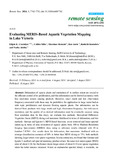Evaluating MERIS-Based Aquatic Vegetation Mapping in Lake Victoria

View/
Date
2014Author
Cheruiyot, Elijah K
Mito, Collins
Menenti, Massimo
Gorte, Ben
Koenders I, Roderik
Akdim, Nadia
Language
enMetadata
Show full item recordAbstract
Delineation of aquatic plants and estimation of its surface extent are crucial to
the efficient control of its proliferation, and this information can be derived accurately with
fine resolution remote sensing products. However, small swath and low observation
frequency associated with them may be prohibitive for application to large water bodies
with rapid proliferation and dynamic floating aquatic plants. The information can be
derived from products with large swath and high observation .frequency, but with coarse
resolution; and the quality of so derived information must be eventually assessed using
finer resolution data. In this study, we evaluate two methods: Normalized Difference
Vegetation Index (NDVI) slicing and maximum likelihood in terms of delineation; and two
methods: Gutman and Ignatov's NDVI-based fractional cover retrieval and linear spectral
unmixing in terms of area estimation of aquatic plants from 300 m Medium Resolution
Imaging Spectrometer (MERIS) data, using as reference results obtained with 30 m
Landsat-7 ETM+. Our results show for delineation, that maximum likelihood with an
average classification accuracy of 80% is better than NDVI slicing at 75%, both methods
showing larger errors over sparse vegetation. In area estimation, we found that Gutman and
Ignatov's method and spectral unmixing produce almost the same root mean square (RMS)
error of about 0.10, but the former shows larger errors of about 0.15 over sparse vegetation
while the latter remains invariant. Where an endmember spectral library is available, we recommend the spectral unmixing approach to estimate extent of vegetation with coarse
resolution data, as its performance is relatively invariant to the fragmentation of aquatic
vegetation cover.
